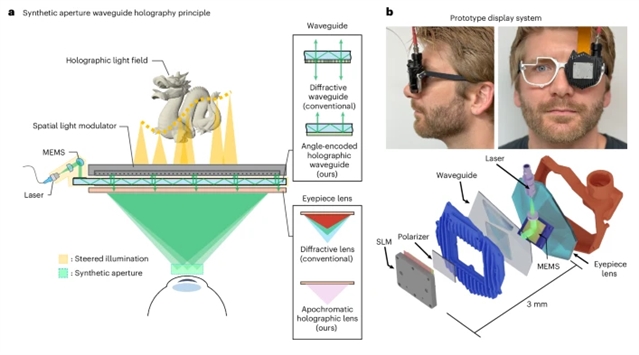
近日,美国斯坦福大学Gordon Wetzstein团队研究了小型混合现实显示器的合成孔径波导全息技术。2025年7月28日出版的《自然—光子学》杂志发表了这项成果。
混合现实(MR)显示系统可在通信、教育、培训和娱乐等各个领域实现变革性主题体验。为了创造一种身临其境和可访问的体验,MR显示器的显示引擎必须在大范围可能的瞳孔位置上可观察到的宽视场上投射感知逼真的3D图像,也就是说,它必须支持大范围的
研究组提出了一种超薄磁共振显示设计,克服了这些挑战,主题是波导全息和人工智能(AI)驱动的全息算法的独特组合。该显示系统的一项关键创新是,为全息近眼显示器定制设计了一种紧凑的波导,该波导支持较大的有效光学扩展量。
这是与一个基于人工智能的算法框架联合设计的,该算法框架结合了隐式大波导模型、部分相干互强的有效波传播模型和计算机生成的全息框架。他们共同设计的波导全息系统和人工智能驱动的全息算法代表了在紧凑的可穿戴设备中创造视觉舒适和感知逼真的3D MR体验的重要进步。
附:英文原文
Title: Synthetic aperture waveguide holography for compact mixed-reality displays with large étendue
Author: Choi, Suyeon, Jang, Changwon, Lanman, Douglas, Wetzstein, Gordon
Issue&Volume: 2025-07-28
Abstract: Mixed-reality (MR) display systems enable transformative user experiences across various domains, including communication, education, training and entertainment. To create an immersive and accessible experience, the display engine of the MR display must project perceptually realistic 3D images over a wide field of view observable from a large range of possible pupil positions, that is, it must support a large étendue. Current MR displays, however, fall short in delivering these capabilities in a compact device form factor. Here we present an ultra-thin MR display design that overcomes these challenges using a unique combination of waveguide holography and artificial intelligence (AI)-driven holography algorithms. One of the key innovations of our display system is a compact, custom-designed waveguide for holographic near-eye displays that supports a large effective étendue. This is co-designed with an AI-based algorithmic framework combining an implicit large-étendue waveguide model, an efficient wave propagation model for partially coherent mutual intensity and a computer-generated holography framework. Together, our unique co-design of a waveguide holography system and AI-driven holographic algorithms represents an important advancement in creating visually comfortable and perceptually realistic 3D MR experiences in a compact wearable device.
DOI: 10.1038/s41566-025-01718-w
Source: https://www.nature.com/articles/s41566-025-01718-w
